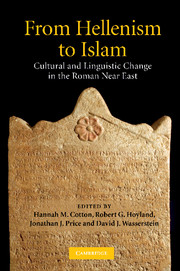Book contents
- Frontmatter
- Contents
- List of figures
- List of tables
- List of contributors
- Preface
- List of abbreviations
- Introduction: documentary evidence, social realities and the history of language
- Part I THE LANGUAGE OF POWER: LATIN IN THE ROMAN NEAR EAST
- Part II SOCIAL AND LEGAL INSTITUTIONS AS REFLECTED IN THE DOCUMENTARY EVIDENCE
- Part III THE EPIGRAPHIC LANGUAGE OF RELIGION
- Part IV LINGUISTIC METAMORPHOSES AND CONTINUITY OF CULTURES
- Part V GREEK INTO ARABIC
- 14 The Nabataean connection of the Benei Ḥezir
- 15 Greek inscriptions in transition from the Byzantine to the early Islamic period
- 16 Arab kings, Arab tribes and the beginnings of Arab historical memory in late Roman epigraphy
- 17 Greek, Coptic and the ‘language of the Hijra’: the rise and decline of the Coptic language in late antique and medieval Egypt
- 18 ‘What remains behind’: Hellenism and Romanitas in Christian Egypt after the Arab conquest
- Index
15 - Greek inscriptions in transition from the Byzantine to the early Islamic period
Published online by Cambridge University Press: 01 March 2010
- Frontmatter
- Contents
- List of figures
- List of tables
- List of contributors
- Preface
- List of abbreviations
- Introduction: documentary evidence, social realities and the history of language
- Part I THE LANGUAGE OF POWER: LATIN IN THE ROMAN NEAR EAST
- Part II SOCIAL AND LEGAL INSTITUTIONS AS REFLECTED IN THE DOCUMENTARY EVIDENCE
- Part III THE EPIGRAPHIC LANGUAGE OF RELIGION
- Part IV LINGUISTIC METAMORPHOSES AND CONTINUITY OF CULTURES
- Part V GREEK INTO ARABIC
- 14 The Nabataean connection of the Benei Ḥezir
- 15 Greek inscriptions in transition from the Byzantine to the early Islamic period
- 16 Arab kings, Arab tribes and the beginnings of Arab historical memory in late Roman epigraphy
- 17 Greek, Coptic and the ‘language of the Hijra’: the rise and decline of the Coptic language in late antique and medieval Egypt
- 18 ‘What remains behind’: Hellenism and Romanitas in Christian Egypt after the Arab conquest
- Index
Summary
The aim of this paper is to examine the epigraphic use of Greek in the last period of Byzantine rule and in the early Islamic period in the region nowadays divided among the State of Israel, the Palestinian Authority, Jordan and Syria, once a patchwork of provinces and parts of provinces of the Byzantine Empire: the three Palaestinae, Arabia and southern Phoenice. This region shared a common cultural and political history in the period indicated, albeit with some chronological variations in its development. I shall endeavour, first, to follow the career of Greek as the main vehicle of expression in epigraphic form, and second, to trace changes in its usage, and in the language itself, if any can be discovered.
The peak of Greek inscriptions in this region, throughout the period of currency of this tongue, was in the sixth and the early seventh centuries. By the end of the eighth century, Greek as an epigraphic medium had ceased to be relevant, though it was still occasionally used in the ecclesiastical milieu, especially in Jerusalem. Ostensibly, what brought about the decline is clear – the impact of the Islamic conquest and the formation of a dominant culture supported by an Arabic-speaking Muslim elite that superseded the former Greek-speaking Christian leading class. Not surprisingly, Greek did not go down without a fight. It survived in private use – namely, in epitaphs – until the eighties of the seventh century (in isolated cases even later, including early medieval occurrences in Jerusalem), and in public inscriptions until the late eighth century (and in Jerusalem and its vicinity even as late as the Crusader period).
- Type
- Chapter
- Information
- From Hellenism to IslamCultural and Linguistic Change in the Roman Near East, pp. 352 - 373Publisher: Cambridge University PressPrint publication year: 2009
- 4
- Cited by

